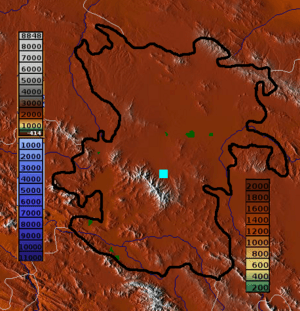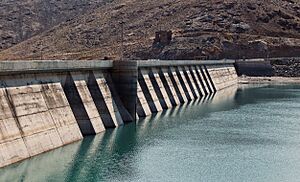Hamadan province facts for kids
Quick facts for kids
Hamadan province
استان همدان
|
|
|---|---|
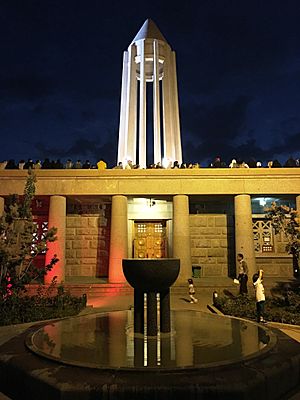 |
|
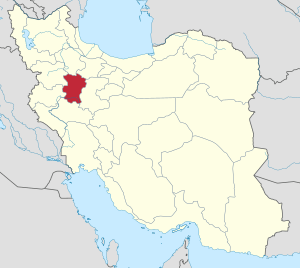
Location of Hamadan province in Iran
|
|
| Country | Iran |
| Region | Region 4 |
| Capital | Hamadan |
| Counties | 10 |
| Area | |
| • Total | 19,493 km2 (7,526 sq mi) |
| Population
(2016)
|
|
| • Total | 1,738,234 |
| • Density | 89.1722/km2 (230.955/sq mi) |
| Time zone | UTC+03:30 (IRST) |
| Main language(s) | Persian, Azerbaijani, Luri, Kurdish |
| HDI (2017) | 0.775 high · 22nd |
Hamadan province (Persian: استان همدان Ostān-e Hamadān) is a province in Iran. It is located in the Zagros Mountains. The capital city is Hamadan. This province covers an area of about 19,546 square kilometers. In 2016, about 1.7 million people lived here.
Some of the main cities in Hamadan province include Asadabad, Bahar, Famenin, Malayer, Nahavand, and Tuyserkan.
Contents
History of Hamadan Province
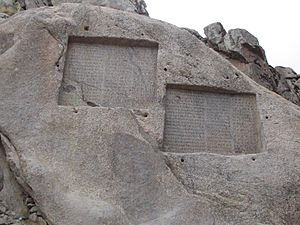
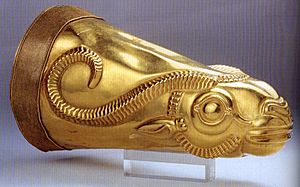
Hamadan province is one of the oldest parts of Iran. It has a very long history. The city of Hamadan is what remains of Ecbatana. Ecbatana was the capital city of the Medes people before they joined with the Persians. Some stories say King Jamshid built Ecbatana.
Ancient records tell us there was a castle called Haft Hessar (Seven Walls) in the city. It had a thousand rooms and was as grand as the Babylon Tower. The city's buildings date back to Diya Aku, a King of the Medes from around 700 BC. The Greeks called this area 'Ekbatan' or 'Hegmataneh'. This king made it a huge capital city.
During the Parthian era, Ctesiphon became the main capital of Persia. But Hamadan was used as a summer capital and a place for Parthian rulers to live. After the Parthians, the Sassanids also built their summer palaces in Hamadan.
In 633 AD, the war of Nahavand happened. Hamadan was taken over by Arab invaders. Over time, the city had good and bad periods. It suffered a lot of damage during the Buwayhids' rule. In the 11th century, the Seljuks moved their capital from Baghdad back to Hamadan.
The city of Hamadan was often affected by wars and changes in power. It was completely destroyed when the Timurids invaded. However, it grew strong again during the Safavid era. In the 18th century, Hamadan was taken by the Ottomans. But Nader Shah Afshari took it back. A peace treaty then returned it to Iran.
Hamadan city was located on the famous Silk Road. This meant it was important for trade and business. Even in recent centuries, it has been a key part of the main road network in western Iran.
Local Jewish traditions say that Hamadan city is mentioned in the Bible. It was known as Shushan and was the capital of ancient Persia during the time of King Ahasuerus. The Tombs of Mordecai and Esther are found in modern-day Hamadan.
Geography and Nature
Hamadan province is in western Iran. It is in the eastern part of the Zagros mountains. The province covers about 1.2% of Iran's total land area. It shares borders with six other provinces. To the north, it borders Qazvin and Zanjan provinces. The Kharaqan mountains form a natural border there. To the east, it borders Markazi province. In the south, Mount Garu forms a natural border with Lorestan province. To the west, Hamadan province borders Kermanshah and Kordestan provinces.
Hamadan province is mostly a mountainous area. The Alvand mountain range is just south of Hamadan city. It is the highest point in the province, reaching 3,580 meters above sea level. The lowest point is 1,420 meters above sea level. This is in the valley of the Gamasiab river near Nahavand. Most of the province's rivers start from the snowmelt on Mount Alvand. They then flow north or south. In summer, when there is little rain, most rivers become very small or dry up.
There are two main flat areas (plains) in the province. One is in the northeast and east, stretching from Hamadan north to Avaj. The other is in the south, between Tuyserkan and Malayer.
In the past, much of the province had light oak forests. But over time, many trees were cut down. Now, only about 4,100 hectares of forest remain. Most of these are in the valleys of Mount Alvand. Most of the province's land is now used for farming (about 48%) or pastures for animals (almost 46%).
Mountains in Hamadan
Besides Mount Alvand, Mount Garu, and the Kharaqan range, Hamadan province has other important mountains:
- Mount Lashgardar, southeast of Malayer, is 2,928 meters high.
- Mount Khangurmaz, northwest of Tuyserkan, is 2,868 meters high.
- Mount Siahdarreh, northwest of Tuyserkan, is 2,818 meters high.
- Mount Safid Kuh, northeast of Hamadan.
- Mount Garma and Mount Sarma, both near Malayer.
- Mount Almuqulak, between Asadabad and Bahar, is 2,997 meters high.
- Mount Buqati, northeast of Hamadan.
Rivers and Water
The rivers that flow north and east from Mount Alvand often dry up in summer. The main ones are the Talvar and the Qarachay. The Talvar river eventually joins the Safidrud, which is Iran's longest river. The Qarachay river starts in the Alvand mountains. It flows east and reaches Lake Qom.
The main rivers south of the Alvand range are the Gamasiab and the Qelqelrud. The Gamasiab starts southeast of Nahavand. It flows through the Nahavand plain.
The most important dam in the province is the Ekbatan Dam (also called Shahnaz Dam). It was built in 1963 on the Yalfan River. The dam helps provide water for farming.
Climate of Hamadan
Hamadan province usually has long, cold winters and mild summers. It often has between 120 and 140 days of frost each year. The mountains are covered in snow for 6 to 8 months. Temperatures can range from -32°C in winter to 39°C in summer. But average temperatures are usually between -4°C in December and 25°C in July. The weather is generally warmer the further south you go. The province gets more rain than average, about 315 mm per year. Almost no rain falls in summer.
Wildlife in Hamadan
The valleys between the mountains have springs and small lakes. These are home to migratory birds. For example, the Talab-e Aqgol marsh is visited by 10,000 to 20,000 birds every year. They stop here on their way from Siberia and Scandinavia to warmer places. These birds stay for 4 to 5 months. Some of these birds include geese, ducks, herons, cranes, and aigrettes.
Several wildlife reserves in the province protect other birds and mammals. Larger birds include royal eagles, golden eagles, falcons, hawks, owls, and vultures. Larger mammals include wild goats, ibexes, wild boars, wolves, foxes, jackals, and hyenas. The number of these animals is usually stable, meaning there is a good balance between predators and their prey.
People of Hamadan
In 1996, about 1.6 million people lived in Hamadan province. A little less than half lived in cities. About half of these city dwellers lived in Hamadan city itself. More people have moved to cities since the 1990s. About 868,000 people lived in rural villages. Some people belonged to tribes that moved between summer and winter homes in the province.
Most people in Hamadan province are Muslim, making up 99.88% of residents in 1996.
In 1996, over 77% of the province's population could read and write. For younger people (6-10 years old), almost everyone could read and write because more schools were available.
Languages Spoken
In Hamadan city, most people speak Persian. Persian is also used as a common language in other areas. In the northern part of the province, most people speak Azerbaijani. In the western areas, near Kermanshah and Kordestan provinces, people speak Kurdish. Luri and Laki are also spoken in some areas, like around Malayer and Nahavand.
| Languages in Hamadan Province | ||||
|---|---|---|---|---|
| language | percent | |||
| Turkic | 35.02% | |||
| Persian | 34.08% | |||
| Luri | 21.00% | |||
| Kurdish | 8.33% | |||
| Other, mixed | 1.59% | |||
Economy of Hamadan
Hamadan province has good rainfall and easy access to water. This makes it a strong area for farming. Agriculture is the biggest part of its economy. The province has about 4.5% of Iran's total farmland. About 950,000 hectares of land are used for farming, which is about 48% of the province's total area. About one-third of this farmland uses irrigation (watered by systems), while the rest relies on rain.
Hamadan province produces about 2.2 to 2.6 million tons of farm products each year. This is about 4.8% of Iran's total. The largest crop grown is wheat. Barley is the second largest. Potatoes and sugar beets are also very important crops. About 6.1% of the farmland is used for orchards (fruit trees).
| Crop | Area Grown (hectares) | Amount Produced (tons) | Yield (tons per hectare) |
|---|---|---|---|
| Wheat | 396,497 | 604,162 | 1.52 |
| Barley | 53,119 | 124,756 | 2.35 |
| Potato | 13,877 | 405,828 | 29.24 |
| Sugar beet | 10,792 | 260,775 | 24.16 |
Hamadan province has many natural resources. It is the biggest source of granite in Iran. It also has limestone, lead, iron ore, and zinc. In 2023, a large amount of Lithium (8.5 million tons) was found in the province.
Small-scale handicraft industries are also important. These include tanning (making leather), carpet weaving, making ceramics, and knitting. There are also larger factories that make things like farm machines, building machines, aluminum products, and steel. Food factories make dairy products, canned fruits, sugar, and soft drinks. Textiles, plastics, and household goods are also made here.
Colleges and Universities
Hamadan province has many places for higher education:
- Bu-Ali Sina University
- Hamedan Medical University
- Hamedan University of Technology
- Islamic Azad University of Hamedan
- Islamic Azad University of Nahavand
- Islamic Azad University of Toyserkan
- Malayer University
- Payam Noor University of Bahar
- Payam Noor University of Hamedan
- Payam Noor University of Kabootar Ahang
- Payam Noor University of Nahavand
- Payam Noor University of Razan
- Payam Noor University of Toyserkan
Places to Visit
Iran's Cultural Heritage organization lists 442 important historical and cultural sites in Hamadan. This makes the province a great place to visit.
Some of the most popular attractions are:
- Tomb of Baba Taher (a famous poet)
- Ganj Nameh inscriptions by Darius The Great
- Tomb of Esther and Mordechai
- Ali Sadr (Ardeles) cave
- Tomb of Avicenna (a famous doctor and philosopher)
- Waterfall of Ganjnameh
- Stone Lion of Hamedan
- Abass Abad jangle (Baugh)
- Qorban Building
- Alavian Tomb
- Eram Park
- Hegmatane (Ekbatan) City, which is 5000 years old
- Imam (Pahlavi) Square
- Alvand Mountain
- Grand Bazaar of Mozafarieh
Images for kids
See also
 In Spanish: Provincia de Hamadán para niños
In Spanish: Provincia de Hamadán para niños


